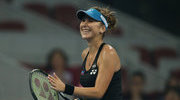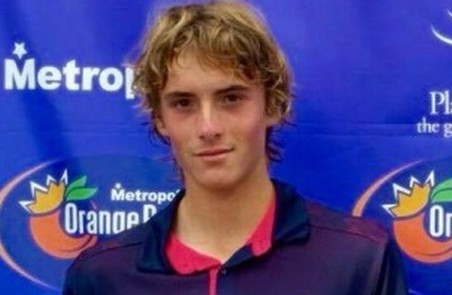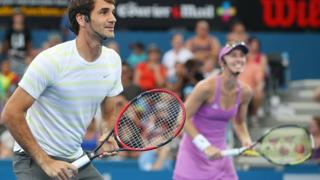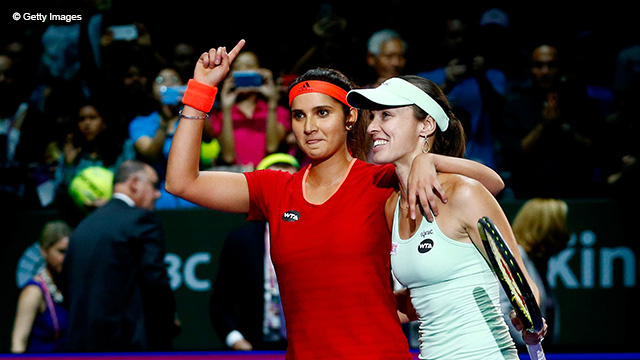Brian Baker says the low point came as he sat in yet another operating room before undergoing elbow surgery in 2008. It was to be his fifth surgery in a matter of three years. There was the left hip (twice), the right hip, a sports hernia and now elbow reconstruction. He’d been through the wringer.
The onetime tennis prodigy thought to himself: “I’m not going to keep having surgeries to prolong my career.”
Born in Nashville, Tennessee, a town known more as a country music hub than a tennis proving ground, Baker turned pro at 18 in 2003, a 6-foot-3 baseliner who could hit the cover off the ball. He had reached the junior boys final at Roland Garros that year, coming up just short against Stan Wawrinka 7–5, 4–6, 6–3. Over the next few years, he would grind it out on the Challenger circuit, slowly working his way into the Top 200 in the Emirates ATP Rankings. But that’s when his body began to betray him. So removed was he from his life as a touring pro during the prolonged rehab stints that he enrolled at Belmont University in Nashville, where he began pursuing a business degree while serving as an assistant tennis coach.
He launched his first comeback in the summer of 2011. His breakthrough came the following spring on the red clay of Nice. Ranked a lowly No. 216, he shocked then 13th-ranked Gael Monfils en route to his first ATP World Tour final, falling to Spaniard Nicolas Almagro 6-3, 6-2. At Roland Garros, he ousted Xavier Malisse in the opening round before pushing Gilles Simon to five sets in a 6-4, 6-1, 6-7(4), 1-6, 6-0 loss. As a qualifier at Wimbledon, he went all the way to the Round of 16, beating Jarkko Nieminen and Benoit Paire. He would climb to a career-high No. 52.
It was at Wimbledon that a reporter likened Baker’s existence to a “collection of preparing for surgeries, recovering from surgeries, preparing for tests.” It wasn’t what Baker wanted to hear, but there was some truth there. And as fate would have it, he would soon find himself sidelined yet again. He retired from his second-round match-up with Sam Querrey at the 2013 Australian Open with knee issues, playing just three more events that year, his last match a 6-3, 4-6, 6-3, 6-4 loss to Lleyton Hewitt at the US Open.
Now 30, he hasn’t played an ATP World Tour-level match since. But using his protected ranking, the American has gained main-draw entry into the 2016 Australian Open. We caught up with the Tennessean just hours after doctors gave him the OK for a comeback, something he’s grown all too familiar with.
ATP: Rumor is that we’re going to see you back on the court in 2016.
BB: I got back from the doctor yesterday in Vail, kind of a final checkup, and they liked what they saw. They said I was free to train the way I want to train, as long as I’m smart about it, and do what I can next year.
ATP: Was it still the knee?
BB: Yeah. The main limitation has been my right knee. When I injured myself in Australia in 2013, it was a lateral meniscus tear that they repaired. I had a good recovery, but right when I started coming back it started swelling. I didn’t think it was that serious, so I played three tournaments before I realised things weren’t very good. I had a couple of cleanup surgeries, but it didn’t really help too much. It got to the point where I could play hard for a day or two, but it just wouldn’t really react well to playing day in, day out. It turned into a cartilage defect. It wasn’t a huge one, but I ended up biting the bullet and having surgery out in Colorado at the Steadman Clinic in Vail. I had it New Year’s Eve last year, a procedure called DeNovo NT, where they basically take juvenile stem cells and glue them on to your defect. It’s kind of the same thing as microfracture. It’s just been a really long recovery.
ATP: You’ve unwittingly become a medical expert, tossing around complex medical terms.
BB: I’m pretty well versed in what I’ve had done, which is pretty significant at this point. I know a few things.
ATP: You’re no stranger to comebacks, but looking ahead at 2016, what are your realistic hopes, your expectations?
BB: I’m not going to put any pressure — I shouldn’t say that because I’m super competitive when I step on the court — but I’m going to try not to put too much pressure on myself because I just started hitting balls again in September and I’m still not playing very much, every other day. I know I’m not going to be at my best in the early part of the year, but as long as I’m feeling strong and healthy my game will come around. I’ve never been concerned with that. I’m hitting the ball fine right now. It’s just a different animal. I haven’t played Top-50, Top-30 guys in a couple of years. It’s just going to be getting back to match tough, making sure I’m able to be smart about my schedule, my training and everything else. As I’ve shown over the years, I‘m definitely prone to injury. It’s just a matter of being smart about it. Hopefully, I can learn from my mistakes and just get lucky. Some of it has just been unlucky circumstances.
ATP: Are you working with a coach at the moment?
BB: I don’t have a guy who has signed on to travel with me next year yet, but in Nashville, where I’ve been training, I have a few different people that I work with for yoga, rehab, weight training.
ATP: It’s been a dozen years since you turned pro. Does it feel like it’s been that long?
BB: I haven’t thought about it like that just because I’ve had so much time off. I guess that says I’m old. That was a long time ago. But I’m just looking forward to trying to start fresh again. I don’t know if it makes it that much easier that I’ve gone through this before. I guess it does in some aspects. On the other hand, I know how hard it is. It’s a balance. I definitely know what’s in front of me and how hard it’s going to be to get back to where I was right before I got hurt.
ATP: Are you comforted by the fact that the elite players aren’t peaking until their late 20s these days, and many are still going strong into their 30s?
BB: It definitely shows that you can play a little bit longer than before. A lot of that has to do with the way they train, they way they eat. The only negative to that is those guys have had so many years as a good base that I’ve missed. But it is refreshing to see that with the medical advancements you can play for a while out there.
ATP: You once said, “I don’t think anybody goes onto the court 100 per cent healthy every match. If they do, props to them.” Do you marvel when you look at a guy like Roger Federer, given how many matches he’s played over the past decade and a half, how he’s been able to play relatively injury-free?
BB: It’s crazy. I know Murray had the back surgery, Rafa had his knee, but for the most part the guys at the top of the game have been healthy throughout their careers. That’s probably just a testament to their work ethic and the teams around them. They’re doing everything they possibly can to get a leg up on the competition as far as taking care of their bodies, good schedules, good training. They’re probably built better than most of us and they’ve had a little bit of luck go their way, too. I’ve tried to do that the best that I can, but so many things happen to you. Every time you get back, it’s like you’re starting from scratch again.
ATP: You don’t seem like a guy who questions his work ethic.
BB: No. But right when you start feeling decent, you can’t go back to your normal training. If I do that, I’m going to hurt something else. That’s the hardest thing; you want to work hard and make up for lost time, but if you do that you’re going to set yourself back.
ATP: During your last comeback in 2012, you said you never gave up hope. What is it about tennis, the very elemental nature of it, that you love the most; that keeps you coming back for more? It would have been easy for you to fall back on your studies and walk away from the game.
BB: That’s a fair question. It’s just something that I’ve done my whole life, since I was three years old. My whole family is into tennis. It’s just something that I’ve enjoyed doing. It’s just one of those sports where you have a lot more control. I’m not saying I didn’t enjoy some aspects of team sports, but there’s just something about the control. If you put in the work, the practice and go out and perform that day, you’re going to win the match. You don’t have to rely on anyone else. You’re the one who has the final say. I miss the traveling, playing the Grand Slams. Like you said, no one is making me come back. I could have stopped at any point. I did go ahead and get my college degree. I graduated in May. But I’ve always liked playing. I’ve always enjoyed the competition, putting it all on the line.
ATP: You finished your business degree at Belmont?
BB: Correct. I always wanted to get my degree. I just didn’t know when it would happen. I don’t know if you can say it in this way, but the one benefit of being hurt was that I was able to get it finished. Of course, I would have traded that for getting it at 35 after a good 12-year career. It’s been a rough road, but at least I was able to get something done.
ATP: Speaking of colleges, when you were coming up through the juniors, reaching the Roland Garros final, you had your pick — Stanford, Florida, Georgia, Duke and Virginia were all chasing you. At any point did you second-guess your decision to turn pro, or did you know that wasn’t your path?
BB: No, I never really questioned that. I might have questioned a few things along the way, but not that decision. Honestly, I think I was mature enough to handle the losing that goes on. Most guys who turn pro aren’t used to losing much. I think I was mature enough to handle that. If I had gone to college and gotten injured like I did on the tour, I don’t know if I would have tried to come back. I wouldn’t have known that I could have success out there. It makes it a little bit easier to come back and push yourself when you know that you’re good enough to compete and have success out there.
ATP: There have been plenty of American women in the pipeline for the last several years, but something was missing on the men’s side. Now there seems to be an American Renaissance of sorts — Taylor Fritz, Tommy Paul, Reilly Opelka, William Blumberg. What are your thoughts on their potential?
BB: When I was helping the USTA this summer, Tommy was there, Reilly, Francis Tiafoe. I thought they were really good. I think a couple of those guys, at least, are going to have a really successful pro career. I don’t want to put any pressure on them now because they’re so young, but I definitely think that new group should have some success going forward.
ATP: Are you one to dole out advice for them?
BB: Take care of your body. [Laughs.]
ATP: Anything else?
BB: It’s really just being able to take the ups and the downs. When you come out there, most of the time you’re not going to have instant success as an 18-, 19-year-old like you might have been able to do 15, 20 years ago. The game has gotten so much more physical. I think those guys have a pretty good mindset. I’ve talked to them a little bit and they seem like they’re maybe not happy-go-lucky, but they’re able to take the ups and the downs pretty well. They don’t get too high or too low.





